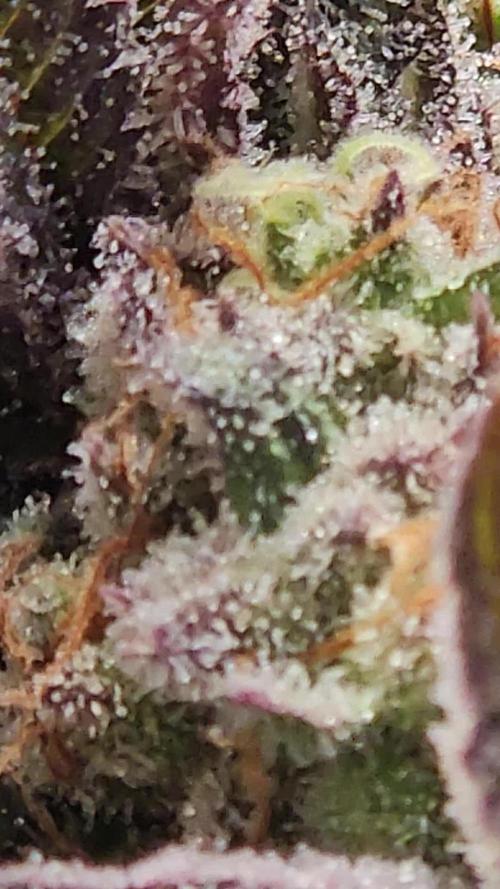The Grow Awards 2026 🏆 


































Likes
Comments
Share


@Swanberg
Follow
Everything must go!!! Day 66 can’t imagine the cheese, the gift, and straw to last much longer. Trellis was removed and you can really tell how heavy some colas are damn near uproots some of plants without the support. I needed to save my trellis ;). Anyways Skittlez in dark period ready to be chopped, tropical fuel is on day 3 of drying and looks to be retaining that “fuel” smell ( no woody buds here!) made some awesome canna butter from the trim of white widow. Happy growing!
Likes
26
Share


@Slurpy_Terpy
Follow
==> Decreased the base nutrients for less Nitrogen
She is doing great!
Smelling stronger than last week :D
Calyxes swelling nicely :)
Starting to get some color already :D
The nice smells of watermelon candy and sour weed are slowly intensifying and the macro pictures surprised me!
I can't wait till she is ready :D
Likes
11
Share


@samuraifroggig
Follow
End of Week 3 switched back to "Snoop's Premium Nutrients Radical Roots"
Likes
10
Share


@SkunkyDog420
Follow
Hallo zusammen 🤙.
Sie wächst sehr schön und macht keine Probleme
Rabattcode für den BIOTABS-Webshop https://biotabs.nl/en/shop/ GDBT420, damit erhalten Sie 15 Prozent
Likes
25
Share


@Sators
Follow
Day 71. Watering with 2.5L nutrient mix.
Day 73. Watering with 2.5L nutrient mix.
Day 75. Watering with 2.5L nutrient mix.
Day 77. Flushing with clear water. 10L
Likes
4
Share


@NuttyYeti
Follow
Gonna top her soon. For now she can grow. She's looking good and healthy 😍✌️💚
Likes
7
Share


@DannywithaJ
Follow
Habe zum Ende der 13ten Woche nochmal die Trichome unter dem Mikroskop begutachtet und die Pflanze für soweit befunden. Konnte mir hier viel Beratung verschaffen und bin nun guter Dinge dass alles gut wird. Das Licht ist aus und wird ausgebaut, das Zelt auf die Trocknungsphase vorbereitet. Die Pflanzen lasse ich nun noch für 2 oder 3 Tage im Dunkeln bevor ich mit dem Ernten beginne. Die Pflanzen zeigen Mängel da ich bereits seit einer woche am Flushen bin. Ich bin bisher mit den Ergebnissen zufrieden und muss ehrlich sagen: White Label hat mich kein Stück enttäuscht. Jeder Samen keimte. Jede Pflanze war stark und hat mir auch mal den einen oder anderen Fehler verziehen ohne gleich kaputt zu gehen. Ich bin mehr als zufrieden mit der Wahl meiner Samen und hoffe nun die Ernte in ein Paar Tagen gut abschliessen zu können.
Likes
2
Share


@Islandgrowbro
Follow
Plants moved to final growing area. Lights added. Ground cover to be added. Spraying done to help fight fungus, insects and some nutrient application.
Likes
12
Share


@CURATI_DA_SOLO
Follow
Purtroppo nessuna vendemmia per colpa di qualche ragazzo che mi ha rubato tutte le mie 9 piante gorilla Zkittlez- gelato- strowberry gorilla- wedding glue- purple punch-strowberry banana-Gorilla cookies- blackberry- mimosa cake....che male al cuore ragazzi quanti sacrifici non potete capire!!!!
Likes
43
Share


@valiotoro
Follow
Hello everyone 😎
Week 3 of flower for the Cherry Cola auto from Fast Buds 💥
She grew fast with a beautiful green color,for the nutrient 4ml/L terra bloom & 1ml/L power buds from Plagron
Spider Farmer SE-7000 70%
Have a nice day 😋
Processing
Likes
142
Share


@MadeInGermany
Follow
Hey everyone :-).
The last plants were also placed in the bloom chamber kammer.
Everyone has made great progress this week 🙏🏻.
There is not much to say about this week, I think videos and pictures say more like words 🙈😎.
I wish you all a good start into the week :-) Stay healthy and let it grow 🙏🏻👍
Likes
11
Share


@NiBaMeCa420
Follow
unprecedented how fast they grow they grow on average off 10 cm per day which I have never experienced on soil but had many problems to keep the pH under control I do notice that less is more on rdwc now that I have reduced the nutrition, the pH remains a lot more stable 4 days ago they transferred to 12 12 now comes the fun part I also ordered a co2 set so from next week we will add co2 to the space
Likes
12
Share


@2Stones1Bird
Follow
Checkout my Instagram @smallbudz to see the Small budget grow setup for indoor use, low watt, low heat, low noise, step by step.
13/12/2019 - Change the light schedule to 12-12h after 8 weeks of no signs of flowering I think is a photo not and auto.
16/12/2019 - Fed her 1.5l of 6.5PH water with 0,5ml of each: Grow, Bloom and Max, and 1ml of each: Heaven, Alga-mic and Vera, noticed about 10% run off, I use about 1/3 of the nutrient dosage on the chart, to achieve about 200/300PPM (500 scale).
17/12/2019 - Did some defoliation on the lower branches mainly.
Likes
7
Share


@unclewoody3
Follow
Some of these were planted later but all doing good at all or not topped
Likes
4
Share

About to start flushing in about a week or so
Likes
20
Share


@eldruida_lamota
Follow
Que pasa familia, vamos a añadir la cuarta semana de floración de estas Apple Fritter de RoyalQueenSeeds, empezamos con la temperatura que la tenemos entre los 21/25 grados, la humedad está entorno al 50%, el ph está en 6.2 , el foco actualmente lo tengo encendido 12 horas y la potencia es al 100% de lo que da el foco.
También añado la gama de nutrientes de Agrobeta, que no falla, sin duda de la mejor alimentación que hay para tus plantas.
Veremos estas próximas semanas como avanzan y se comportan en la floración.
Mars hydro:
Code discount: EL420
https://www.mars-hydro.com/
Agrobeta:
https://www.agrobeta.com/agrobetatiendaonline/36-abonos-canamo
Hasta aquí todo, Buenos humos 💨💨💨
Likes
2
Share


@EyeMKing
Follow
Started the first top dressing of Gaia Green All Purpose and Power Bloom at a 50/50 ratio of 1tbsp/gal each.
Likes
3
Share


@NoProbation4Weed
Follow
The Buds are getting Frosty and heavy.
The Fruity smell turned into Dank-Cali Flower with way deeper notes to it.
light hits the plant with around 750 PPFD.



























